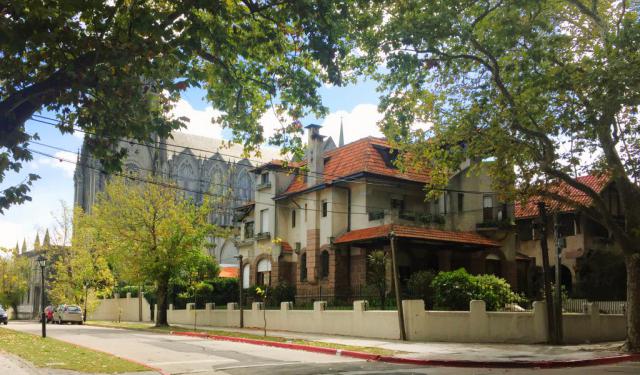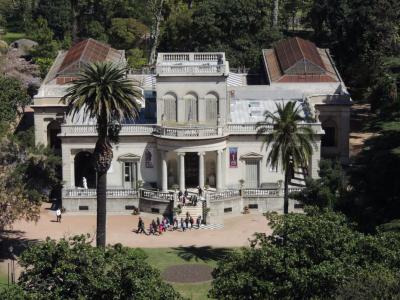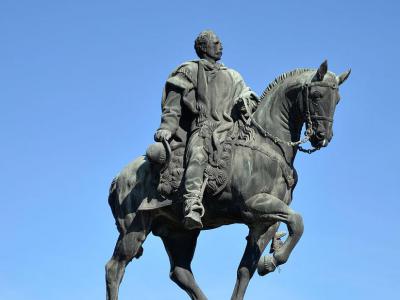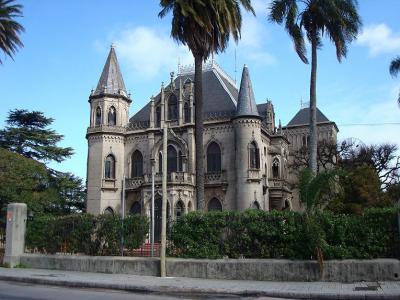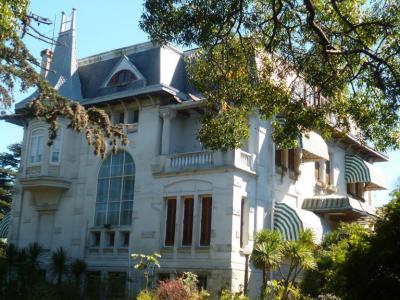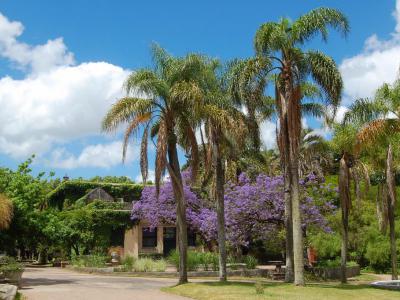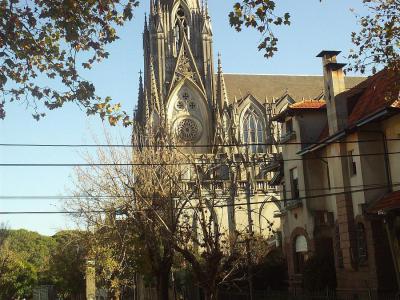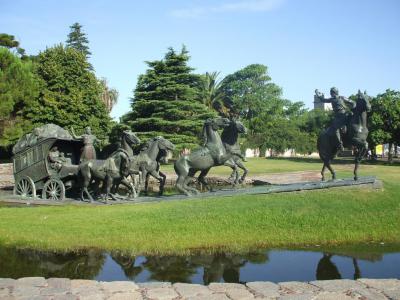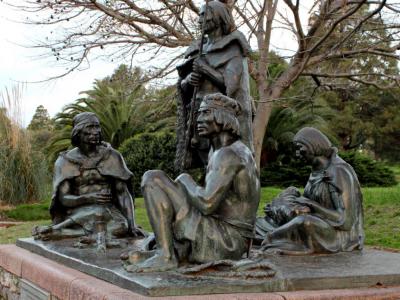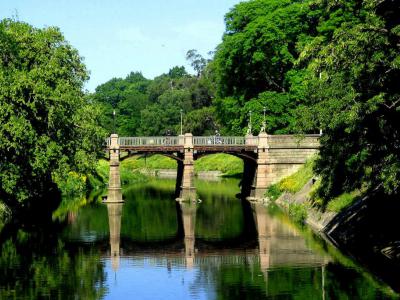Prado District Walking Tour (Self Guided), Montevideo
A quiet, upscale barrio El Prado, in the north of Montevideo, is famous primarily for the sprawling park of the same name. Indeed, the city’s main green space, Parque del Prado is a major public venue made up of grassy fields, with the Arroyo Miguelete (Miguelete Creek) running through it, for which the neighborhood has been dubbed "the lung of the city".
Apart from the park, however, the area boasts a number of other places of interest, including the Juan Manuel Blanes Museum of Fine Arts, housed in a 19th-century villa and exhibiting the works of national, Latin American and European art from the 15th to the 20th centuries.
The peaceful, tree-lined streets of the district are lined with mansions built in the early 1900s. Chief among them, undoubtedly, is Residencia de Suarez, an official home of every president of Uruguay since 1947. Also here is one of the most beautiful buildings in Montevideo, the Neo-Gothic Soneira Castle, built in 1861; currently accommodating an educational institution. Right behind it is the Montevideo Botanical Garden, a large fenced park with over 1,000 plant species.
The neighborhood is full of Christian temples of various denominations. The 1920s-built Church of Our Lady of Mt. Carmel and St. Thérèse of Lisieux, popularly known as "Iglesia de los Carmelitas", is perhaps the most photographed among them.
For a more detailed acquaintance with these and other attractions of El Prado, take our self-guided walking tour and enjoy this part of the Uruguayan capital to the fullest!
Apart from the park, however, the area boasts a number of other places of interest, including the Juan Manuel Blanes Museum of Fine Arts, housed in a 19th-century villa and exhibiting the works of national, Latin American and European art from the 15th to the 20th centuries.
The peaceful, tree-lined streets of the district are lined with mansions built in the early 1900s. Chief among them, undoubtedly, is Residencia de Suarez, an official home of every president of Uruguay since 1947. Also here is one of the most beautiful buildings in Montevideo, the Neo-Gothic Soneira Castle, built in 1861; currently accommodating an educational institution. Right behind it is the Montevideo Botanical Garden, a large fenced park with over 1,000 plant species.
The neighborhood is full of Christian temples of various denominations. The 1920s-built Church of Our Lady of Mt. Carmel and St. Thérèse of Lisieux, popularly known as "Iglesia de los Carmelitas", is perhaps the most photographed among them.
For a more detailed acquaintance with these and other attractions of El Prado, take our self-guided walking tour and enjoy this part of the Uruguayan capital to the fullest!
How it works: Download the app "GPSmyCity: Walks in 1K+ Cities" from Apple App Store or Google Play Store to your mobile phone or tablet. The app turns your mobile device into a personal tour guide and its built-in GPS navigation functions guide you from one tour stop to next. The app works offline, so no data plan is needed when traveling abroad.
Prado District Walking Tour Map
Guide Name: Prado District Walking Tour
Guide Location: Uruguay » Montevideo (See other walking tours in Montevideo)
Guide Type: Self-guided Walking Tour (Sightseeing)
# of Attractions: 9
Tour Duration: 2 Hour(s)
Travel Distance: 3.6 Km or 2.2 Miles
Author: jenny
Sight(s) Featured in This Guide:
Guide Location: Uruguay » Montevideo (See other walking tours in Montevideo)
Guide Type: Self-guided Walking Tour (Sightseeing)
# of Attractions: 9
Tour Duration: 2 Hour(s)
Travel Distance: 3.6 Km or 2.2 Miles
Author: jenny
Sight(s) Featured in This Guide:
- Juan Manuel Blanes Museum
- Aparicio Saravia Statue
- Castillo Soneira (Soneira Castle)
- Residencia de Suarez (Suarez Residence)
- Jardin Botanica (Botanical Garden)
- Iglesia Carmelitas (Carmelite Church)
- Monumento A La Diligencia (Stagecoach Monument)
- The Last Charrúas Monument
- Parque Prado (Prado Park)
1) Juan Manuel Blanes Museum
Juan Manuel Blanes was born in Montevideo in 1830. He was an accomplished portraitist and landscape artist. He achieved fame with his "social" painting, "Episode of Yellow Fever," in 1871. He was celebrated for his depictions of historical events and heroes, especially his portrait of Jose de San Martin, the hero of Argentine independence.
Blanes died at the age of 70 in Pisa, Italy, in the house of a friend. In 1930, the city of Montevideo named the Municipal Museum of Fine Arts in his memory. The museum is located in the Palladio Villa (Palladio House) in Prado Park on the banks of Miguelete Creek.
The house was designed and built in 1870 by Uruguayan architect Juan Alberto Capurro for The Italian Consul, Juan Bautista Roffo. The museum was renovated in 1929 by architect Eugenio Baroffio. He expanded the building but left the eclectic facade intact.
Juan Manuel Blanes Museum holds Uruguayan art dating from the beginnings of the nation until the present day. The permanent collection includes works of Juan Manuel Blanes, Pedro Figari, Rafael Barradas, Jose Cuneo, and Carlos Gonzales.
Behind the Museum is the Japanese Garden of Montevideo. It was donated in 2001 by Japanese Princess Sayako.
Blanes died at the age of 70 in Pisa, Italy, in the house of a friend. In 1930, the city of Montevideo named the Municipal Museum of Fine Arts in his memory. The museum is located in the Palladio Villa (Palladio House) in Prado Park on the banks of Miguelete Creek.
The house was designed and built in 1870 by Uruguayan architect Juan Alberto Capurro for The Italian Consul, Juan Bautista Roffo. The museum was renovated in 1929 by architect Eugenio Baroffio. He expanded the building but left the eclectic facade intact.
Juan Manuel Blanes Museum holds Uruguayan art dating from the beginnings of the nation until the present day. The permanent collection includes works of Juan Manuel Blanes, Pedro Figari, Rafael Barradas, Jose Cuneo, and Carlos Gonzales.
Behind the Museum is the Japanese Garden of Montevideo. It was donated in 2001 by Japanese Princess Sayako.
2) Aparicio Saravia Statue
The equestrian statue of Aparicio Saravia (1856 – 1904), a Uruguayan politician and military commander, member of the Uruguayan National Party, refers to an era of civil unrest in Uruguay. A revolutionary leader at the helm of a 15,000-strong army, Saravia waged war against the Uruguayan government at the turn of the last century. After his death in battle in 1904, the army was disbanded and the so-called Saravian Revolution, the last civil war in Uruguayan history, came to an end, followed by the Peace of Aceguá which finally brought stability to the country.
The statue is the work of José Luis Zorilla de San Martin (1891–1975), a prominent Uruguayan sculptor and painter, whose style is characterized by a blend of baroque and modern elements. The creative vision of Zorrilla de San Martín regarding monumental sculpture is best described with his own words: “Strong and powerful in every element. Without a shade of doubt or obscurity, but simple and eloquent. Thousands of men, women and children will pass by a monument every day, going about their business: work, home, school or amusement. I would like each of them, within a brief moment that they can dedicate to a bronze statue, to get a categorical and conclusive message of patriotism, freedom and courage; a message that will be the voice of the glorious tradition of our nation.”
Although the original sketches for the monument were drawn around 1930, it was only a quarter of a century later that it finally materialized – cast at the prestigious Vignali foundry. Commissioned by the Directorate of the National Party, Zorrilla de San Martín unveiled the statue – one of his last works and artistic legacy for both the city and the country – on May 18, 1956.
The depiction of Aparicio Saravia, the caudillo clad in poncho, with a hat, mounted on a horse “whose agile ears look like antennas receiving messages from the fields and jungles,” is an enduring symbol of the homeland of warriors on horseback. "The eastern land that is guarded here has the blood of the heroes who, [together] with General Aparicio Saravia, spilled it on the battlefields in the fight for civic liberties," says the inscription at the foot of the monument. The suggestive patina of time and the horizontal gaze of the caudillo, fixed in bronze, show that here, once again, tradition becomes spirit.
The statue is the work of José Luis Zorilla de San Martin (1891–1975), a prominent Uruguayan sculptor and painter, whose style is characterized by a blend of baroque and modern elements. The creative vision of Zorrilla de San Martín regarding monumental sculpture is best described with his own words: “Strong and powerful in every element. Without a shade of doubt or obscurity, but simple and eloquent. Thousands of men, women and children will pass by a monument every day, going about their business: work, home, school or amusement. I would like each of them, within a brief moment that they can dedicate to a bronze statue, to get a categorical and conclusive message of patriotism, freedom and courage; a message that will be the voice of the glorious tradition of our nation.”
Although the original sketches for the monument were drawn around 1930, it was only a quarter of a century later that it finally materialized – cast at the prestigious Vignali foundry. Commissioned by the Directorate of the National Party, Zorrilla de San Martín unveiled the statue – one of his last works and artistic legacy for both the city and the country – on May 18, 1956.
The depiction of Aparicio Saravia, the caudillo clad in poncho, with a hat, mounted on a horse “whose agile ears look like antennas receiving messages from the fields and jungles,” is an enduring symbol of the homeland of warriors on horseback. "The eastern land that is guarded here has the blood of the heroes who, [together] with General Aparicio Saravia, spilled it on the battlefields in the fight for civic liberties," says the inscription at the foot of the monument. The suggestive patina of time and the horizontal gaze of the caudillo, fixed in bronze, show that here, once again, tradition becomes spirit.
3) Castillo Soneira (Soneira Castle)
In 2017, the College of San Pablo in Montevideo acquired Soneira Castle and the Castle lands to expand its campus. The property reached back to the Botanic Gardens. It included an 18-hole golf course, an Olympic size swimming pool, a tennis court, and more. But the jewel of the purchase is the mysterious, emblematic Castle.
The so-called Castle is the ultimate 19th-century Neo-Gothic residence. It far exceeds anything Hollywood's Adams family could hope for. Its actual address is Avenida Suarez 3781, next door to the Presidential Residence. It was built in 1861 for the Soneira family of Montevideo by French architect Victor Rabu.
In 1914 architect Camille Gardelle renovated the property, using original materials imported from Europe. The Castle in its original form was a bit smaller. It had two main floors, used for habitation and reception. The basement was used by the household staff. The attic was a studio for the son of the family.
The interior comfort was brought up to date with central heating and electrification. Imported materials included Venetian and Florentine tiles for the floors, Slovenian oak, and Carrara Marble for the stairs. The windows now have stained glass.
The so-called Castle is the ultimate 19th-century Neo-Gothic residence. It far exceeds anything Hollywood's Adams family could hope for. Its actual address is Avenida Suarez 3781, next door to the Presidential Residence. It was built in 1861 for the Soneira family of Montevideo by French architect Victor Rabu.
In 1914 architect Camille Gardelle renovated the property, using original materials imported from Europe. The Castle in its original form was a bit smaller. It had two main floors, used for habitation and reception. The basement was used by the household staff. The attic was a studio for the son of the family.
The interior comfort was brought up to date with central heating and electrification. Imported materials included Venetian and Florentine tiles for the floors, Slovenian oak, and Carrara Marble for the stairs. The windows now have stained glass.
4) Residencia de Suarez (Suarez Residence)
The Presidential Residence of Suárez y Reyes is the prestigious official residence of the President of Uruguay. It is situated at the strategic corner of Suárez and Reyes streets in the Prado neighborhood of Montevideo, with the scenic Montevideo Botanic Garden at its rear. This iconic building represents not only a piece of Uruguay's architectural heritage but also a testament to its political history.
The residence’s story began in 1907 when Adelina Lerena de Fein purchased the land at an auction. The following year, the construction of a three-story house was commissioned to the young architect Juan María Aubriot, who completed the ambitious project in 1908. The building initially served as the private residence of the Fein Lerena family.
Following the demise of the original house owner, the property changed hands several times. The next significant owner was German Werner Quincke, who acquired the estate and commissioned the architect Karl Trambauer to make substantial renovations, including its distinctive tower. After the Quincke family, the property was briefly owned by the Susviela Elejalde family, who eventually surrendered their rights to the Montevideo Municipality due to financial hardships.
A twist of fate linked the property to presidential history in 1925, when Luis Batlle Berres and Matilde Ibáñez Tálice, both future significant figures of Uruguay, met while walking in front of the residence. They married soon after, and decades later, in 1947, Luis Batlle Berres became the President of Uruguay. Influenced by his wife, Batlle Berres chose this mansion as the official presidential residence. To suit its new role, the mansion underwent further renovations under architect Juan Scasso, known for designing the Centenario Stadium.
Today, the Suarez Residence remains a symbol of Uruguayan leadership, blending historical architecture with the continuous narrative of the country’s political life. Its location and its historical backdrop make it not only a residence but also a significant landmark in Montevideo’s urban and cultural landscape.
The residence’s story began in 1907 when Adelina Lerena de Fein purchased the land at an auction. The following year, the construction of a three-story house was commissioned to the young architect Juan María Aubriot, who completed the ambitious project in 1908. The building initially served as the private residence of the Fein Lerena family.
Following the demise of the original house owner, the property changed hands several times. The next significant owner was German Werner Quincke, who acquired the estate and commissioned the architect Karl Trambauer to make substantial renovations, including its distinctive tower. After the Quincke family, the property was briefly owned by the Susviela Elejalde family, who eventually surrendered their rights to the Montevideo Municipality due to financial hardships.
A twist of fate linked the property to presidential history in 1925, when Luis Batlle Berres and Matilde Ibáñez Tálice, both future significant figures of Uruguay, met while walking in front of the residence. They married soon after, and decades later, in 1947, Luis Batlle Berres became the President of Uruguay. Influenced by his wife, Batlle Berres chose this mansion as the official presidential residence. To suit its new role, the mansion underwent further renovations under architect Juan Scasso, known for designing the Centenario Stadium.
Today, the Suarez Residence remains a symbol of Uruguayan leadership, blending historical architecture with the continuous narrative of the country’s political life. Its location and its historical backdrop make it not only a residence but also a significant landmark in Montevideo’s urban and cultural landscape.
5) Jardin Botanica (Botanical Garden)
The Botanical Garden of Montevideo is an open museum of nature, located in the Prado Park of Montevideo. Its official name is "Museum and Botanical Garden Professor Atillio Lombardo." Mr. Lombardo was the Garden and Museum director for 40 years.
The Botanical Garden was created in 1902 by the French landscape architect Carlos Racine. As of today, the gardens occupy more than thirty-two acres of land. It is a brilliant way to escape into the air of nature without leaving the city. On the walks of the gardens are examples of 1,000 species of vegetation.
The Botanical Garden is an oasis where one may find almost every type of flora in South America. There are 1,761 types of trees, some over 100 years old, 620 shrubs, and over 2,400 flowers. Zones harbor the plants according to their environmental needs and peculiar properties, including water, shade, and medicinal qualities.
The gardens breed butterflies. There are 53 species of butterflies living only in the park. Five different families of Lepidoptera are represented. Visitors are allowed to watch them and take photographs. The best times for pictures are spring and summer.
The Botanical Garden was created in 1902 by the French landscape architect Carlos Racine. As of today, the gardens occupy more than thirty-two acres of land. It is a brilliant way to escape into the air of nature without leaving the city. On the walks of the gardens are examples of 1,000 species of vegetation.
The Botanical Garden is an oasis where one may find almost every type of flora in South America. There are 1,761 types of trees, some over 100 years old, 620 shrubs, and over 2,400 flowers. Zones harbor the plants according to their environmental needs and peculiar properties, including water, shade, and medicinal qualities.
The gardens breed butterflies. There are 53 species of butterflies living only in the park. Five different families of Lepidoptera are represented. Visitors are allowed to watch them and take photographs. The best times for pictures are spring and summer.
6) Iglesia Carmelitas (Carmelite Church)
The Carmelite Church (Iglesia Carmelitas), also officially known as the Church of the Virgin of Mount Carmel and Saint Therese of Lisieux, stands as a notable Roman Catholic parish church nestled in the serene Prado district of Montevideo. Constructed from 1929 to 1954, the church is a masterpiece of Neo-Gothic architecture, distinctly inspired by the iconic Notre Dame Cathedral in Paris. Architects Guillermo Armas and Albérico Isola are credited with designing this architectural marvel.
Covering an impressive breadth of 131 feet, the church structure showcases three naves and is topped by a solitary tower that majestically punctuates the skyline. The exterior is lavishly adorned with religious statues, including prominent figures such as Saint Teresita de Jesus and Saint John of the Cross, adding depth and sanctity to its architectural splendor.
Upon entering, visitors are greeted with austerely beautiful interiors, where the sunlight dances through stunning stained glass windows, creating a kaleidoscope of vibrant colors illuminating the carvings and religious sculptures within. The church's acoustics are finely tuned, ideal for the resonant singing that occasionally fills the space.
The church, initially managed by the Carmelite Order until 1995, now falls under the jurisdiction of the Archdiocese of Montevideo. It was declared a parish in 1962 and is dedicated to Our Lady of Mount Carmel and Saint Therese of Lisieux, the latter being a French Carmelite nun revered in modern times.
The Carmelite Church is not just a place of worship but a cultural beacon and an architectural treasure in Montevideo, meriting appreciation for both its spiritual significance and its grandeur. Whether for prayer, architectural admiration, or historical curiosity, the Church of the Carmelites offers a unique and enriching experience to all who visit.
Covering an impressive breadth of 131 feet, the church structure showcases three naves and is topped by a solitary tower that majestically punctuates the skyline. The exterior is lavishly adorned with religious statues, including prominent figures such as Saint Teresita de Jesus and Saint John of the Cross, adding depth and sanctity to its architectural splendor.
Upon entering, visitors are greeted with austerely beautiful interiors, where the sunlight dances through stunning stained glass windows, creating a kaleidoscope of vibrant colors illuminating the carvings and religious sculptures within. The church's acoustics are finely tuned, ideal for the resonant singing that occasionally fills the space.
The church, initially managed by the Carmelite Order until 1995, now falls under the jurisdiction of the Archdiocese of Montevideo. It was declared a parish in 1962 and is dedicated to Our Lady of Mount Carmel and Saint Therese of Lisieux, the latter being a French Carmelite nun revered in modern times.
The Carmelite Church is not just a place of worship but a cultural beacon and an architectural treasure in Montevideo, meriting appreciation for both its spiritual significance and its grandeur. Whether for prayer, architectural admiration, or historical curiosity, the Church of the Carmelites offers a unique and enriching experience to all who visit.
7) Monumento A La Diligencia (Stagecoach Monument)
Jose Belloni was born in Montevideo in 1882. His parents were from Switzerland and Spain. He took an early interest in art and studied sculpture in Lugano and Munich. Jose Belloni participated in numerous exhibitions throughout Europe. He ultimately returned to Montevideo, where his sculptures created a demand for his works in monuments.
His style was naturalist if mildly heroic. One of his major pieces, La Diligencia, (a Stagecoach) struggling to emerge from a mire, sits on the shore of Miguelete Creek at the entrance to Prado Park. The sculpture was moved from its original location to make way for a viaduct.
The piece is strikingly natural and realistic, with bronze horses dragging the coach up from the mud of the creek while the teamster leads their efforts. A woman clutching an infant sit on the stage bench as the stage struggles to emerge from the deeps.
La Diligencia and the Monument a La Carreta (the Carriage) are two significant works of Belloni that resonate with each other. The Carriage monument is in the Batlle Park. To visit the Diligence may take any one of fifteen different omnibus lines. All roads, it seems, eventually lead to the park.
His style was naturalist if mildly heroic. One of his major pieces, La Diligencia, (a Stagecoach) struggling to emerge from a mire, sits on the shore of Miguelete Creek at the entrance to Prado Park. The sculpture was moved from its original location to make way for a viaduct.
The piece is strikingly natural and realistic, with bronze horses dragging the coach up from the mud of the creek while the teamster leads their efforts. A woman clutching an infant sit on the stage bench as the stage struggles to emerge from the deeps.
La Diligencia and the Monument a La Carreta (the Carriage) are two significant works of Belloni that resonate with each other. The Carriage monument is in the Batlle Park. To visit the Diligence may take any one of fifteen different omnibus lines. All roads, it seems, eventually lead to the park.
8) The Last Charrúas Monument
The names of the last Charruas people alive on the planet were Senaque, Vaimaca-Piru, Guyunusa, and Tacuabe. All the other Charruas in the Uruguay area had been wiped out by the waves of European invasion. These four hapless survivors were taken to France to be "studied." They died in France, perhaps from terminal sadness.
The bronze Monument of the Last of the Charruas is in the Prado District, on Avenida Delmira Agustini. The sculpture was created by the Uruguayan artists Edmundo Prati, Gervasio Munoz, and Enrique Lussich. It was unveiled in 1938.
The figures are dressed in their traditional clothes. They are gathered around a fire and cauldron. Senaque, on the left, is seated, holding a cup of mate in his right hand. The cacique (chief), Vaimaca, stands behind. Guyunusa sits, nursing a child. In front of her is her husband, Tacuabe.
These four and the infant were all who survived the Massacre of Saispuedes, carried out by the militia of General Rivera in April 1831. The prisoners were taken to France to be exhibited as exotic savages. The remains of Vaimaca were mummified and returned to Uruguay.
The bronze Monument of the Last of the Charruas is in the Prado District, on Avenida Delmira Agustini. The sculpture was created by the Uruguayan artists Edmundo Prati, Gervasio Munoz, and Enrique Lussich. It was unveiled in 1938.
The figures are dressed in their traditional clothes. They are gathered around a fire and cauldron. Senaque, on the left, is seated, holding a cup of mate in his right hand. The cacique (chief), Vaimaca, stands behind. Guyunusa sits, nursing a child. In front of her is her husband, Tacuabe.
These four and the infant were all who survived the Massacre of Saispuedes, carried out by the militia of General Rivera in April 1831. The prisoners were taken to France to be exhibited as exotic savages. The remains of Vaimaca were mummified and returned to Uruguay.
9) Parque Prado (Prado Park)
Prado Park (Parque Prado), located in Montevideo, is the city's largest public park and a significant cultural and recreational destination. Founded in 1873, it occupies 106 hectares in the Prado neighborhood. The park is nestled in the northern part of Montevideo, with the Miguelete Creek enhancing its scenic beauty.
The park is known for its diverse attractions, including the Presidential Residence situated behind the esteemed Botanical Gardens. The gardens themselves are a highlight, featuring Rosedal, a meticulously designed rose garden. Established with 12,000 roses imported from France in 1910, Rosedal is adorned with four pergolas, eight domes, and a central fountain, creating a picturesque setting. This area is bordered by several major avenues, including Agraciada and Luis Alberto de Herrera, enhancing its accessibility and prominence.
Prado Park is not only a haven for nature lovers but also a cultural hub, hosting two significant museums. The Juan Manuel Blanes Museum, housed in a Palladian villa designated as a National Historic Landmark in 1975, showcases a rich collection of artworks and features a serene Japanese garden. Established in 1930, this museum serves as a cultural cornerstone. Nearby, the Professor Atilio Lombardo Museum and Botanical Gardens, founded in 1902, offer insights into botanical science and education.
Additionally, the National Institute of Physical Climatology and its observatory are located within the park, further emphasizing its role in scientific study. Across the Miguelete Creek, the Prado extends into the smaller Prado Chico area in the neighborhood of Paso de las Duranas, considered an extension of the main park.
Prado Park, with its blend of natural beauty, historical significance, and cultural richness, remains a cherished landmark in Montevideo, offering residents and visitors alike a peaceful escape and a deep dive into the city's heritage.
The park is known for its diverse attractions, including the Presidential Residence situated behind the esteemed Botanical Gardens. The gardens themselves are a highlight, featuring Rosedal, a meticulously designed rose garden. Established with 12,000 roses imported from France in 1910, Rosedal is adorned with four pergolas, eight domes, and a central fountain, creating a picturesque setting. This area is bordered by several major avenues, including Agraciada and Luis Alberto de Herrera, enhancing its accessibility and prominence.
Prado Park is not only a haven for nature lovers but also a cultural hub, hosting two significant museums. The Juan Manuel Blanes Museum, housed in a Palladian villa designated as a National Historic Landmark in 1975, showcases a rich collection of artworks and features a serene Japanese garden. Established in 1930, this museum serves as a cultural cornerstone. Nearby, the Professor Atilio Lombardo Museum and Botanical Gardens, founded in 1902, offer insights into botanical science and education.
Additionally, the National Institute of Physical Climatology and its observatory are located within the park, further emphasizing its role in scientific study. Across the Miguelete Creek, the Prado extends into the smaller Prado Chico area in the neighborhood of Paso de las Duranas, considered an extension of the main park.
Prado Park, with its blend of natural beauty, historical significance, and cultural richness, remains a cherished landmark in Montevideo, offering residents and visitors alike a peaceful escape and a deep dive into the city's heritage.
Walking Tours in Montevideo, Uruguay
Create Your Own Walk in Montevideo
Creating your own self-guided walk in Montevideo is easy and fun. Choose the city attractions that you want to see and a walk route map will be created just for you. You can even set your hotel as the start point of the walk.
Montevideo Old Town Walking Tour
In 1683, the Portuguese founded a city called Colonia do Sacramento across the bay from Buenos Aires. Field marshal Manuel da Fonseca built a fort there he called Montevieu. In 1724, the Spanish governor of Buenos Aires, one-armed Bruno Mauricio de Zabala, forced the Portuguese out and changed the name of the city.
Bruno and the Spanish settlers called their new city "Saint Philip and... view more
Tour Duration: 2 Hour(s)
Travel Distance: 2.5 Km or 1.6 Miles
Bruno and the Spanish settlers called their new city "Saint Philip and... view more
Tour Duration: 2 Hour(s)
Travel Distance: 2.5 Km or 1.6 Miles
The Most Popular Cities
/ view all
